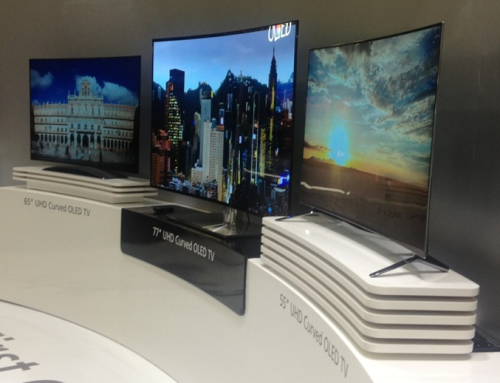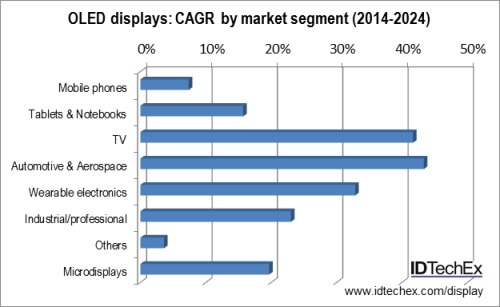IDTechEx forecasts that the market for plastic and flexible OLED displays will rise to US $16 billion by 2020. This is one of the conclusions highlighted in their latest report OLED Display Forecasts 2014-2024: The Rise of Plastic and Flexible Displays. The new market research report includes detailed 10-year forecast by market segments, but also by display type (AMOLED, PMOLED, etc.).
Uniquely, this report distinguishes between rigid plastic displays and flexible displays. The former are already commercialized in handsets such as the Samsung Galaxy Round or the LG G Flex (Note: the G Flex is a little bit flexible but mostly rigid in normal use). The OLED displays in these devices are not manufactured on glass but on a polyimide substrate, a plastic known for its resistance to high temperatures. We can expect the first flagship phone with a flexible display to ship in 2017. Based on this scenario, the market for plastic and flexible AMOLED displays will grow to US $16 billion within the next six years.
 |
|
Source: IDTechEx report OLED Display Forecasts 2014-2024: The Rise of Plastic and Flexible Displays (All Image and Photo Courtesy belong to ID TechEx) |
In an effort to provide a granular analysis, the market forecasts have been split between eight major market segments, including mobile phones, TVs, automotive, and wearable electronics. Wearable technology is certainly a hot topic and the proliferation of smart watches and fitness bands is driving the sales of very small (below 2 inches) OLED panels. OLED TVs, which have only been recently launched, are critical for the growth of the OLED display market. The main product features have been the extended color gamut, high contrast, ultra-thin form factor, as well as the fact that the panel can be curved (as shown in the picture below). Compared to other segments, the market for OLED TV panels is currently relatively small. However, it is projected that it will be in strong growth over the next ten years, with a CAGR of 42%.
 |
|
Curved OLED TVs from LG (Photo: H. Zervos, IDTechEx) |
 |
|
Source: IDTechEx report OLED Display Forecasts 2014-2024: The Rise of Plastic and Flexible Displays |
As always with IDTechEx publications, the report is not just about market forecast but also includes an extensive description of the technologies available with company profiles of key players in the value chain. We have leveraged the many years of tracking progress in the various components of OLED displays (substrates, TFT, barrier films, etc...) to critically assess the technical challenges that remain. And because we have been following printed electronics for more than a decade, we have also included a chapter on the progress of printing in OLED display manufacturing. OLED Display Forecasts 2014-2024: The Rise of Plastic and Flexible Displays is the most recent addition to the emerging materials and devices group of technology and market research reports by IDTechEx. Read more at: http://www.idtechex.com/research/articles/the-rise-of-plastic-and-flexible-oled-displays-00006736.asp?donotredirect=true














